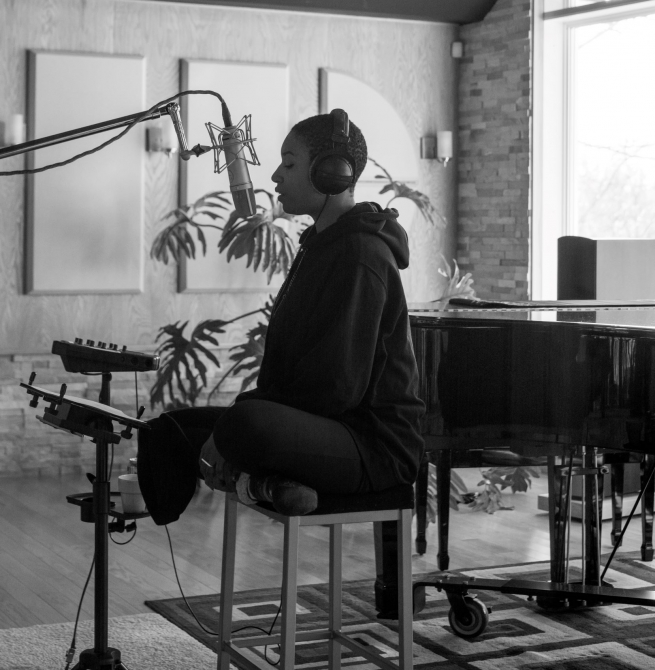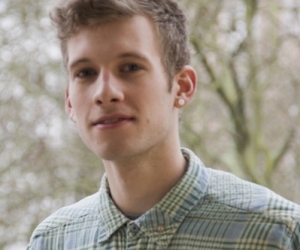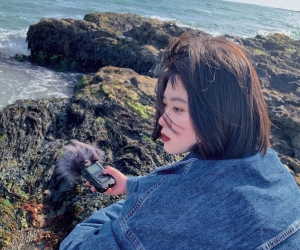
On the 2004 live-concert recording Tour de Force, the renowned American poet and musician Gil Scott-Heron introduces his 1981 song “Is That Jazz?”: “Go to your record store . . . look at the bottom shelf, you will find a box called miscellaneous. We are miscellaneous. We did not mean to be miscellaneous. Somehow it happened. Otherwise you go to the record store . . . you look in a box called jazz . . . then I looked up jazz in the dictionary and it means ‘miscellaneous.’ We were not happy. We decided to bring the music to you, let you decide. What kind of music do we play?”
Dominique Fils-Aimé—a mercurial singer and composer, whose music, like Scott-Heron’s, weaves between jazz and soul—ponders the same thing. “When people try to put me in a box it doesn’t work,” she says, from her Montreal apartment. “I’m always doing whatever feels right at that moment and that’s allowed me to collaborate with electronic artists and R&B, folk.” When we speak, she is just a week away from the release of Stay Tuned, the second in her planned trilogy of albums (Nameless, her debut, came out in 2018; the third will be released in 2020).
“I want people to open their minds to different types of music,” she continues. “I want people to bring me in so that I can be somewhat of a bridge for [them] to reconsider the notion of boxes in music.”
Her recent creative collaborations with Jordanian-born, now Montreal-based electronic-music artist Ohm Hourani on his album Jazz of the Machine was another opportunity to do what she loves—be a bridge and freely create. “He set up this whole musical computer lab and let every piece run on its own for hours. The machines just jammed together, and he’d capture a part of that jam between them. Then we [musicians] collaborated with the machine. To me that’s jazz— the concept of being free in your creations and just doing something new and innovative.
“You could feel the real struggle from the musicians, but that’s what makes it real,” she explains. “It was not about perfecting tracks, it was about the first feeling, the first instinct, the first expression of whatever comes.”

Dominique Fils-Aimé’s family moved from Haiti to Canada before she was born. From the start, her mother, a doctor, raised her first-generation children to know that Canada was their country. “She would tell me, ‘You are wherever your feet are. This is your land. You’re allowed to be anywhere, and you belong anywhere you choose to be and to contribute.’” Their home was filled with music, which instilled the idea that—like the medicine her mother practised—music itself is healing. “On Sunday afternoons, when we had family supper, there was always a lot of music playing, and the door [would be] wide open so if friends or family passed, they could walk in and have dinner with us. The same way the sun came into the house through the door, the music from inside our home was sending the same vibe out to the street.” She also vividly recalls nights when an album held her so enthralled that she couldn’t asleep.
“I become so invested, it was like meditation,” she recalls.
Her older sister studied opera and boasted an enviable CD collection that became Fils-Aimé’s treasure trove, introducing her to artists such as Bob Marley, B.B. King, Marilyn Manson, and Etta James. But it was one particular experience—listening to Janet Jackson’s 1997 album The Velvet Rope on a warm summer night, as light from a streetlamp poured through her open blinds—that sealed her passion once and for all. “I had listened to [Velvet Rope] repeatedly, and then magically, suddenly, at the end of the album I hear a little sound begin—it was a hidden track. I had never even heard of that concept. I’d been listening to it for three days and now you tell me there’s more! It was completely magic.”
But while music was her emotional and spiritual passion, Fils-Aimé was keenly aware that her mother was working hard to provide for her children opportunities she herself had never had. Fils-Aimé often felt torn, wondering if she should pursue music—a luxury her mother’s generation never had. Or should she take the stable path her mother walked? Her mother, for her part, was having none of it, telling her daughter, “I want you to be happy. Whatever job you chose, if it’s your passion, you’re going to work overtime, and you will succeed.”
Fils-Aimé received an arts and science undergraduate degree from Concordia, with a focus on creative writing. In 2013, she took time off from her job providing psychological support for workers, in order to devote more time to making music, doing things like volunteering to sing background vocals for other artists. Early on, she had no idea what harmonies were. She used Apple’s music-studio software program GarageBand to train her ear, learn how to harmonize, and, most importantly, to develop her own musical language. “I don’t play an instrument, and I can’t write music, so I mastered using my voice as my instrument to show and direct musicians—I hear the bass like this, and the guitar like that.”
The self-guided music journey gave her a new appreciation of legendary music artists. “To me, music is about being directly connected to your emotion, being vulnerable, and expressing it. When you listen to singers like Billie Holiday, sometimes they’re not in key but the emotion is real. I feel like, since the last generation, we’ve acquired so many tools to perfect the aesthetic, visual, and auditory that it’s erased a piece of the humanity in music—that discovery of raw new sounds. We accepted people and the sounds of their flaws back then. There was a real diversity and genuineness.”
Inspired by American music genres like soul and jazz, Fils-Aimé found herself singing and writing in English, unintentionally disguising her lovely French accent. “French is a very specific language,” she explains. “It’s very vulnerable, very complex poetry. You use long metaphors to say something, as if you’re hiding the message. There’s something direct about expressing your emotions in English. You can just scream out exactly what you mean. I got my musical education in English, so it comes naturally to me.”
In 2015 she made it to the semifinals of the Canadian version of the TV show The Voice. It gave her a chance to experience what lies behind the “big industry machine” she heard so many aspiring musicians fret about. “I discovered that behind [the] machine there’s always people, and people come in all shapes and forms. I discovered amazing people from the artists to the staff. It becomes a family. [But] people are not really connecting with you at that moment, they’re connecting with the show, and you are part of a cast.” Still, she left with a feeling of accomplishment. “At the end of the day, everyone who expresses themselves has won, whether it was appreciated by others or not.” After The Voice, she shifted away from the mainstream route, turning instead to the past.
Dominique Fils-Aimé’s trilogy was birthed from historical stories and sounds—slave ships moving in the dead of night, the kaleidoscope of innovative sounds from African-American musicians that exploded in the 1920s, and the sensual, uninhibited celebration felt in the soul, reggae, and disco music that came later.
“Some parts are based on my [realizing] that I didn’t know my history, because black history is not really taught in schools. Then I discovered that I did know [it]—I knew it through music. I knew the emotions. You have humans who are impacting and creating music, and [this] music creating history and changing people. That was a big revelation.”

Fils-Aimé has synesthesia (the ability to see colours associated with sounds, notes, or pitches), which has given her music an additional layer of meaning. She saw the three primary colours (blue, red and yellow) as reflecting the cycle that humans have gone through, both historically and personally. “Nameless begins in the blue of nighttime—the crossing of the slaves through water. Silence is an instrument; people did not speak up when they should have, silence has heaviness—the presence of something that’s missing. Red (Stay Tuned) is the heat; the freedom acquired through music: jazz was the fire and people were revolting. And then yellow represents finally getting freedom; people were able to celebrate with soul music. They finally got to dance in disco and reggae. Everything that’s sunny and hopeful came after that period.”
The albums are designed to fit together like pieces of a puzzle. “They’re parts of the same story. The first notes of Stay Tuned are the last notes of Nameless. You can mix them and listen to them in one single journey. That’s the goal.” On the first two albums, she’s made conscious decisions, both in her songwriting and in production, to further the message of her music, such as the drums on “Constructive Interference,” which are played by Salin Cheewapansri—“one of the best drummers I know”—and which Fils-Aimé feels are the heartbeat of the album, just as women are the new heartbeat of the revolution. “Women [are] standing up and adding themselves to the fight. For a long time, they were present, but they were not unified or heard.”
While tracks like “9LRR” and “Revolution Serenade” carry some political heft, she views her message as humanist, not political. “I don’t care for politics, but I do see things I feel need to change, and not speaking up would frustrate me. Music has power. It can introduce a little love and empathy and allow listeners to feel someone else’s truth for a minute.”
Most importantly, Stay Tuned mirrors the power in multiple voices. “There’s more people on it because you need to gather people for a revolution—have more influences and perspectives.” Like Scott-Heron, Fils-Aimé believes the revolution will not be televised, but it will, she asserts, be collaborative. “Real revolution will not be about turning the tables; it will be about everyone having a seat at that table, together.”
Top photo by Jeff Malo; middle photo by Elaine Louw Graham; bottom photo by Alex Uriel Lag.


